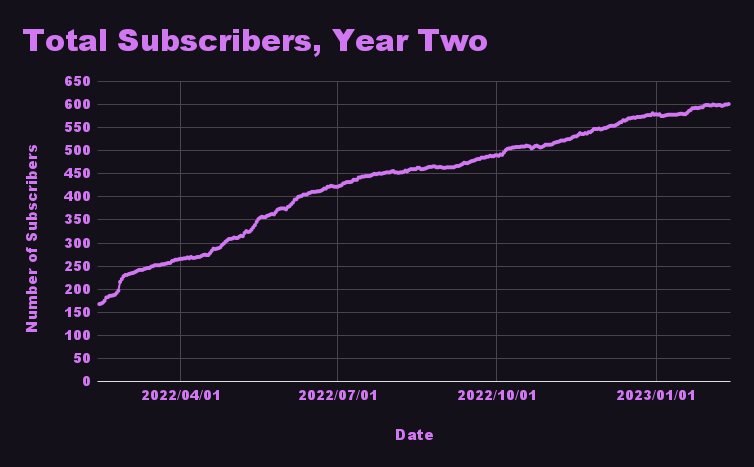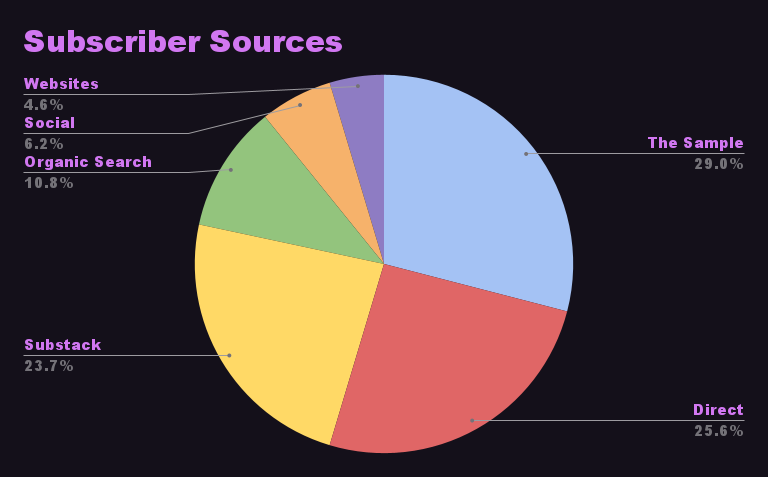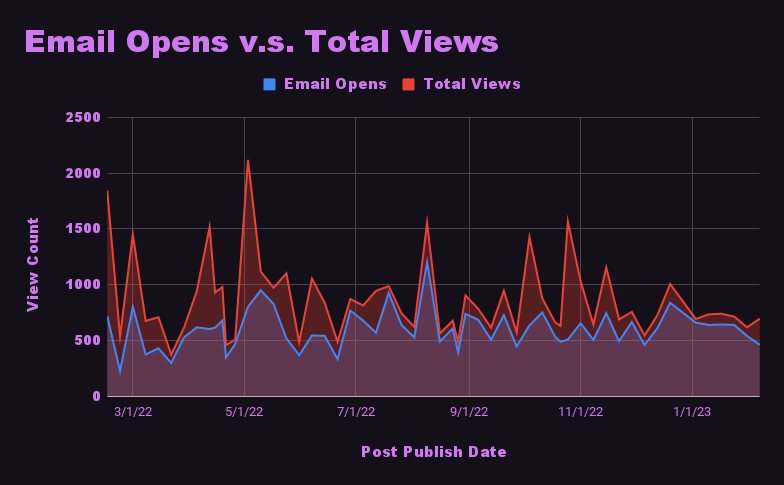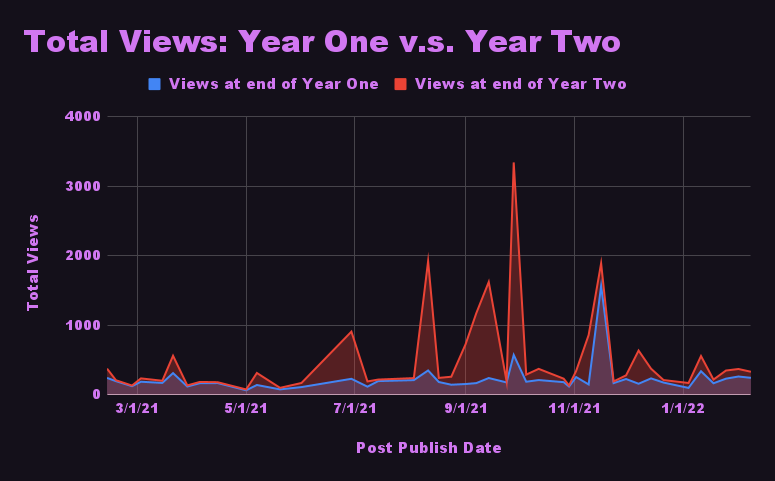Night Water: Year Two
A quantitative look at the second year of this newsletter

On Sunday, February 12, Night Water turned two years old. Just over two years ago, I sent out the first email, about my perpetual obsession with Babyland General Hospital, to just 15 subscribers. Today, I'm sending this email out to just over 600.
I started writing Night Water because I wanted to give myself a reason to write every week. Since then, I've published articles on everything from the dangers of paper plates to the ideal Halloween playlist, guest posts on important subjects like the Cheesecake Factory menu, and podcasts about the radio precursors to CSI. You never know what you might get when you open Night Water, but each late night missive aims to be a refreshing glass of ice cold content in your email inbox.
This is my second annual post looking back at the numbers behind the last year of Night Water: subscriber growth, popular posts, and how articles are ranking on Google Search. I love it when writers give me a peek under the hood at what makes their newsletters tick. While Night Water is, of course, hardly the biggest newsletter in the world, I hope this post is at least somewhat interesting to both my readers and fellow writers alike.
But first: did I actually write something every week?
I had two writing goals for year two of Night Water: 1) publish something on Night Water every week and 2) publish 52 new pieces of writing.
I got pretty close on both goals! I published 55 new posts on Night Water this year, though only 41 of those were my written pieces (I’m including Q&As and Late Night Reads here). The other 13 posts were a mix of podcast episodes, guest posts, and Night Water Cooler discussion threads.
For the purposes of this count—and for the entire rest of this post—I won't be including any of the paywalled Day Soda content.
Despite publishing three more posts than there are weeks in the year, I technically fell short of goal #1 after taking a week off between Christmas and New Year. I also fell short of my goal of publishing 52 new pieces of writing. However, with both goals, I made improvements over last year:
Publish every week:
Year One: 87%
Year Two: 98%
Publish 52 new pieces:
Year One: 67%
Year Two: 79%
I was pretty impressed with myself, considering I got married last year and was, all-in-all, pretty busy. It helped to have a standing publish date and time, as well as a content calendar with the next few months of posts planned out in advance. If I was rolling out of bed every week with no idea what to write and no idea when it needs to be finished, I'd likely never publish anything.
To be honest, these goals are a bit of a "solved problem"—sure, if I forced myself to write something brand new every week, and never do any podcast episodes or guest posts, I could hit the second goal. But I don't think that would be sustainable, or very much fun. So while I'll still aim for publishing something new every week in year three, I'm not going to worry so much about making it a brand new piece of writing.
Subscriber growth
Last year, I set a goal of having 334 subscribers by the end of year two—double the number of subscribers that I had at the end of year one. If you've been following along with Night Water's subscriber specials, you'll know that I handily beat that goal and my stretch goal of 500 subscribers.

Night Water ended the year with 601 subscribers. It's truly incredible to think that anyone, let alone strangers, would want to read this every week. Thank you so much for being here.
You're probably wondering—where did all these people come from? Substack does try to estimate the source of each subscription—I cleaned up their raw data and put sources into a few major buckets:

The largest source of new subscribers continues to be The Sample, a meta-newsletter that shares issues from other newsletters. The Sample was a firehose of new subscribers for much of the last year, though it's slowed down significantly in the past few months.
The next bucket is "direct"—which really means "unknown." These are folks for whom Substack could not identify any referral information. They could've typed the URL directly into their browser—i.e., someone told them to sign up and they did it right there on their phone—or clicked a link from a source that didn't pass on any information to the browser.
Third is Substack itself. About half of these are from Recommendations—I'll talk a bit more about that below—and the rest are from sign-up modules on the Night Water site or within the Substack app.
After that is organic search—Google, for the most part—and then social media and other websites.
Note that this data only covers current subscribers. Plenty of people have unsubscribed, but there's no way to see how many people left or where they had come from now that they're gone. That's a bit of a shame—it would be helpful to know if subscribers from Google were 10 times more likely to unsubscribe, for example.
Substack Recommendations
Over the last year, Substack has been adding a lot of features to encourage readers who are already in their ecosystem to sign up for more newsletters. A big part of that is their Recommendations feature. I can recommend another Substack newsletter, and that recommendation shows up in Night Water's sign-up flow, on the Night Water home page, and gets sent out occasionally in Recommendation Digests to current subscribers.
I don't love the way these recommendations are incorporated into the sign-up flow. It's already way too long. I watched someone sign up for Night Water the other day and it was like a game of 20 Questions:
- Do you want a paid or free plan?
- Do you want to sign up for these recommended newsletters?
- Do you want to share Night Water on social media?
- Do you want to join the Night Water chat in the Substack app?
- Do you want to add the Night Water podcast feed to your podcast app?
- Do humans need God to exist?
It's a bit intense, and I wish Substack would let me turn off some of these screens. I don't care if you share Night Water on Twitter or download the Substack app. But of course, Substack cares if you do these things and that matters to them more.
Recommendations have done a good job of bringing in subscribers, but because of the aforementioned flow, I do get concerned that sometimes people don't quite realize what they're signing up for. (Another reason it'd be nice if Substack had better data around unsubscribes and churn.)
I'd like to thank some of the other newsletters that have sent subscribers my way: Game & Word (81 subs), Non-Boring History (16 subs), Rat Report (7 subs), Serial Smithery (5 subs), and Iterate (3 subs).
I've generated over 200 subscriptions for 10 different newsletters (I like to switch my recommendations around a bit). Hopefully, some of you are still reading those other publications!
A quick plug for Day Soda
During year two, I launched Day Soda, an exclusive newsletter for paying subscribers. I won't be going over any stats from Day Soda or the paid subscriptions—I'll save that for Day Soda: Year One in April—but I wanted to take a second in the middle of this post to thank all of my paying subscribers so far. You've helped fund guest writers, interview transcriptions, and the occasional weird vegan frozen food.
Night Water will always be free—unless I get an offer I cannot refuse from Aquafina or Dasani—but if you enjoy this newsletter and have the means, I'd appreciate it if you tried out a monthly or annual paid subscription. It helps keep the newsletter free for everyone else and you'll get some fun bonus daytime content as well, like videos of me opening up French Pokémon cards.
Top posts of the year
As I would expect—and hope—from the increase in subscribers, views of Night Water articles were up across the board in year two. The average Night Water post last year got 869 views (combined email opens and web views) versus an average of 230 in year one.
But the main thing that pushed posts into the top five wasn't email opens, it was web views. Here's an area chart showing the delta between email opens and total views:

When it came to ranking by total views, those web views from social, Google, sharing with friends, and all the other assorted ways people visit websites made all the difference. I imagine this is pretty typical—your email opens shouldn't change drastically from week to week, and if anything are more a reflection of your subscriber base than the popularity of any one piece of content.
Without further ado, here are the top five posts from year two:
5) Set a play date with Bloom (1515 views, April 12)
Sometimes, timing is everything. This piece was about one of the first major games for a niche handheld device that came out last April. Because people were curious about the device and the games available for it, this post got a lot more social traffic than usual. 18% of views came from Reddit, 8% from Twitter, and 7% from Google.
4) 5 more Lucozade flavors I drank this month, ranked (1555 views, August 9)
This is a funny one as it breaks the mold a bit—76% of views came from email, primarily from being sent around by The Sample. I do rank quite highly for Lucozade on Google, with 16% of views coming from the search engine, but this is the only top post that wasn't in the top five for web views alone.
3) We need to talk about bedside water carafes (1567 views, October 25)
At the end of this article, I admitted it was a naked attempt to rank for "bedside water carafe" on Google, and rank it did. 55% of views came from Google! And I'm guessing that all of them were upset to find out that I did not actually recommend any specific water carafes.
2) Night Water: Year One (1843 views, February 15)
Why do we make sequels? Because the original was so darn successful, of course. Much of the traffic here came from direct sharing in newsletter writer's groups and on Substack. If you're reading this sequel post, there's a good chance you got here through the same channels! We'll see if Year Two beats Year One in Year Three.
1) Star Wars should be in the public domain (2118 views, May 3)
Another SEO success story, with 48% of traffic coming from Google. Turns out a good amount of people want to know when Star Wars will enter the public domain. Do they expect an argument against the entire contemporary copyright system when they do so? Probably not, but I won't argue with the results.
What about the archive?
The best part about having the entire archive of Night Water available on the web is that every post has a long life and can continue to be discovered and enjoyed by new audiences, some of whom might just sign up for the newsletter. So I wanted to look back at the archive and see how many views those posts from year one have now at the end of year two. There were a few obvious standouts:

One of my favorite guest posts from the first year, "Guy Love: the masculinity tug-of-war in Scrubs and Ted Lasso", only had 151 views at the end of year one. But it got 710 more views in year two, primarily from Reddit, ranking fifth among archive content for most web views in year two.
There were two other year one posts that weren't part of the original top five, but got so much web traffic last year that it catapulted them to the top: "What's on the Pokémenu?" and "4 Lucozade flavors I drank this month, ranked", with 49% and 71% of their total views coming from Google, respectively.
Google continued to drive traffic to two top performers as well: "It's time to bring back HitClips" and "The Millions Visa card turns your bank account into a lottery," which were the #3 and #2 posts from last year's top five. The Millions Visa Card post got 2766 views last year alone, more than any article from year two.
To me, this just goes to show the power of your newsletter's archive to continue to drive new readers to your publication. While it's great to have a big hit on social drive a ton of subscribers, the slow and steady traffic from organic channels shouldn't be discounted.
Search Engine Optimization
So, let's talk a little bit about how Night Water does on Google! I wrote a lot about how to implement a simple SEO strategy for the Year One post, which I won't repeat here. For the most part, my SEO strategy in year two was the same: I don't necessarily craft my posts to be SEO-optimized (other than the aforementioned water carafe piece), but I do take steps to ensure Google sees Night Water as a trustworthy source. That reputation only builds over time—as more and more people click links to Night Water on Google, the more likely it is they'll rank other pieces highly.
So, the numbers: last year, Night Water got over 9,400 clicks from Google, with over 1.15 million impressions. That's much higher than last year's 623 clicks from 69,000 impressions!
Over 20 URLs got over 100 clicks each, but like last year, most clicks went to the top five, which should be familiar to you by now:
- The Millions Visa Card turns your bank account into a lottery (2027 clicks)
- Star Wars should be in the public domain (834 clicks)
- 4 Lucozade flavors I drank this month, ranked (707 clicks)
- We need to talk about bedside water carafes (680)
- It’s time to bring back HitClips (647 clicks)
While these were the heavy hitters, I always like it when Google helps shed light on some more obscure topics—it's nice to see that at least a few hundred people want Mario Chase on the Nintendo Switch or are curious about the defunct Babyland General location on Fifth Avenue.
Of course, the conversion rate from these readers to subscribers is pitifully low—under 1% almost any way you slice it—but I'll be curious if that math changes over time. Substack only recently introduced a subscribe slide-in on articles, which I hope helps increase conversion from organic and social web traffic.
Looking ahead to Night Water: Year Three
Thanks for making it this far—we're almost at the end. While I hope you enjoyed this look back in the rearview mirror, it's time to stare straight ahead onto an empty road known as the future. Night Water is a highway: I want to ride it all night long.
Like last year, I hope to double the email list in year three from 601 subscribers to 1202. As a stretch goal, let's call that an even 3000.
I'll have more goals around paid subscriptions in Day Soda: Year One this April (sign up today and get that in your inbox in just a few short weeks).
Other than that, I just want to keep publishing something every week, have people read it, and hopefully enjoy it. It's truly a pleasure to stand around the fridge with you all, enjoying that refreshing late night water every week.
If you like being here, too, tell a friend to join us. Leave a like or comment when the mood strikes you and let me know what you think.
Until next time: enjoy those late night vibes.




